![]()
![]()
![]()
Use LEFT and RIGHT arrow keys to navigate between flashcards;
Use UP and DOWN arrow keys to flip the card;
H to show hint;
A reads text to speech;
45 Cards in this Set
- Front
- Back

|
Red figure amphora 530-520bc Andokides painter creator of red figure painting hercules fighting apollo at the oracle of Delphi texture and detail; known for smooth lines possible student of Ezekias |
|

|
Kylix, 520BC, Epiktetos primarily painted cups;single figure in center liked to mess with identies; satyrs pretending to be warriors; bilingual cup-black figure inside red outside simple line |
|
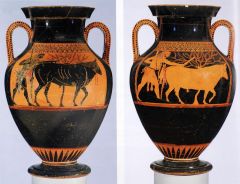
|
bilingual amphora, 525BC Andokides painter and Lysippides painter red one side black the other red figure looks more greek |
|
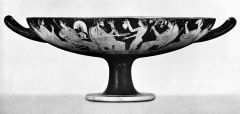
|
Kylix, 515-510BC, Oltos decorates exterior and interior;inside is warrior with shield taking up entire tondo dedicated to Castor and Pollux-shows gathering of the gods |
|
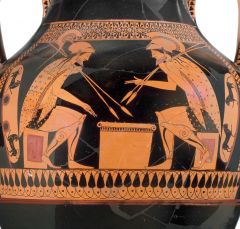
|
bilingual amphora, 525BC Andkides and Lysippides
copy of Ezekias' Ajax and Achilles game image long hands and fingers; detailed clothing-more natural might be student of Ezekias |
|

|
Kylix, 510BC, Oltos loves using large palmettes usually worked with 1 figure Nereid depicted(sea nymph) |
|
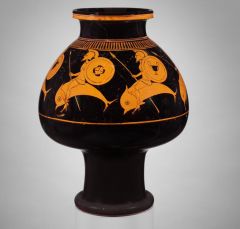
|
Psychter, 515BC, Oltos combination of amphora and phynter; used to chill wine (like a giant ice cube) warriors riding dolphins say "on the dolphins" looks like they're riding them when in liquid |
|
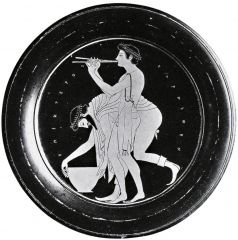
|
plate, 515BC, Epiktetos young boy playing double flute, older man picking up vessel very simple line, but depth in overlapping could represent pederastic relationship |
|
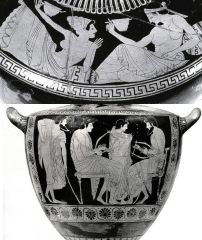
|
Attic hydra, 510BC, Phintias big vases/composition;potter and painter shows music lesson-man is named Euthymides woman playing kottabos is saying "this is for you, Euthymides" good understanding of form and how cloth lays on the body |
|
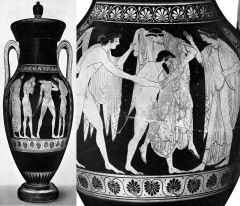
|
Red figure amphora 510-500BC, Phintias Tityos kidnapping Leto; apollo and artemis trying to save her very stagnant for a hectic scene |
|
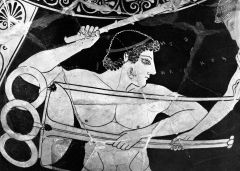
|
attic red figure amphora, 510BC, Phintias
Hercules and apollo at delphi; focus' on large musculature also puts eyelashes on hair is raised off the surface of the vase (in relief) indicates fingernails |
|

|
red figure stamnos, 515BC, Smikros symposium scene; "I am Smikros" next to lounging banqueter noted for intense stares and hand gestures heavy detail on couches and clothes |
|

|
Sarpedon krater, 500BC, Euphronios
shows Sarpedon, son of Zeus, dead on battlefield; Hypnos and Thanatos depicted with Hermes-psychopomp dynamic posing blood and wound extreme detail on wings palmettes separate the images |
|

|
Antaios krater, 510BC Euphronios
shows hercules fighting antaios very detailed muscles;tries to emphasize muscle movement tried to show antaios is a giant and "different" i.e. the hair/face-is also gasping for air-shows teeth |
|

|
Volute krater, 510-500BC, Euphronios
hercules fighting amazons; variation in amazons clothing, large figures |
|

|
psychter, 510BC, Euphronios
Hetaira depicted, one is drinking facing forward the left is named Smikra and speaks, "to you, I dedicate this drop Legros" |
|

|
revelers vase, 510-500BC Euthymides likes working with 3 figure compositions intersted in human form and how it moves; komast depicted as well as Hektor putting on armor with Hecube and Priam more realism in Piram's baldness; "As never Euphronios" |
|

|
Red figure amphora 510-500BC, euthymides
abduction of korone by theseus 3 figures; use of movement, but very stagmant in action- interaction between two sides of the vase |
|

|
Loutrophoros, 480BC, Kleophrades painter
believed to be a student of euthymides 3 figure compositions funerary elongated amphora;more accurate idea of drapery, prothesis at belly |
|

|
Ilioupersis hydria, 480BC, Kleophrades painter sac of troy, Neoptolehos about to beat Priam Ajax the lesser kidnapping Kassandra believed to be inspired by a mural Aeneas, Anchises, and Ascanius fleeing |
|

|
pointed amphora, 490BC, Kleophrades painter
theosos represented showing overlapping shifting of the pupil to give a more profile eye, also showing open mouth |
|

|
Achilles hydria, 480BC, Kleophrades painter
achilles seated in the middle; Odysseus trying to persuade him to come back to battle;more humanistic |
|

|
Hermes and Satyrs amphora, 490BC, Berlin painter
likes working with amphora, focus' on single figure or layered figures vase works together as one because of body language delicate features; elongated figures, detailed hair |
|

|
Europa bell krater, 500-490BC, Berlin painter
Europa running with the bull that would take her to the islande of krete, rape her and leave her mother of Minos; woman on other side chasing her |
|

|
Ganymede bell krater, 500-490BC, Berlin painter
cup bearer to the gods, holds a cock sign of courtship zeus reaching for him;color on his hair shows ganymede was blonde |
|
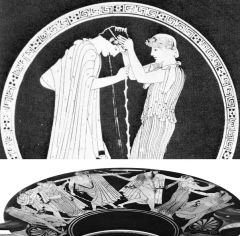
|
komast kylix, 490BC, Brygos painter
master of movement; shows body hair; patterns on clothes, often works in duos (usually romantic) inside shows man throwing up, a consequence the drinker could experience as well |
|

|
Ilioupersis kylix, 490-480BC, Brygos painter
shows Neotalphos going to beat Priam with his dead grandson Stanayx inside is the tent of Achilles, Phoinix talking to Briseis |
|

|
school kylix, 480BC, Douris
shows young man learning for elders, noted for hook collarbone |
|

|
jason kylix, 480-470BC, Douris jason being disgorged by the dragon; athena watching; golden fleece on tree behind an alternate version of the story of jason |
|

|
trojan war kylix, 490BC, Douris
Eos holding the body of Memnon, her tears make zeus give her son immortality shows more emotion than anything |
|

|
satyr psychter, 480BC, Douris
satyrs depicted in various stages of drunkeness wanting people to keep in mind their behavior |
|
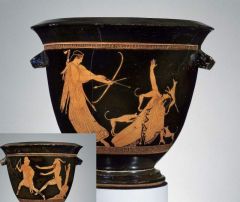
|
Acteon and pan bell krater, 480-470BC, pan painter shows death of Acteon by Athena, pan chasing a shepard; vase represents athens defeat of the persians (they were overprideful) |
|

|
Herakles pelike, 470BC, pan painter
used to hold liquids herakles' visit to egypt where they try to sacrifice him so he kills them shows contrast in nudity and their faces; shows difference in genitals |
|

|
hunter lekythos, 470BC, pan painter
pan chasing a boy; precision of line and form hunter is looking right, body moving left |
|
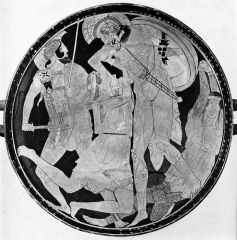
|
Penthesilea kylix, 455BC, penthesilea painter
uses entire tondo of cup, achilles in the midst of stabbing penthesilea; jewelry and word are gilded and in relief likes making huge figures-looked to wall paintings for inspiration |
|

|
zeus and ganymede kylix, 450BC, penthesilea painter zeus forcfully grabbing ganymede who holds a rooster |
|
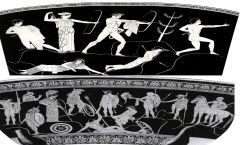
|
argonauts calyx krater 450BC, Niobid painter elongated heavy handed subjects, not steady hand-focus' on form resulting in cold figures inspired by statues and murals created environment likes greeks vs. "others" three quarter view; apollo and athena killing Niobe's children |
|

|
Kaineus stamnos 440BC, Polygnotos
shows Kaineus being beat into the ground centaurs more accurately fused, shows more depth and understanding of human form than previous depictions of this scene |
|

|
Achilles amphora, 440BC, Achilles painter
worked in red/white ground trained w/berlin painter likes single figures excellent draftsman-eye actually in profile adds muscle definition-looked at the spear bearer |
|

|
Hermes lekythos, 440-430BC Phiale painter
given as gifts at tombs;hermes guiding the deceased from her tomb, gives him more human qualities-variety of color |
|
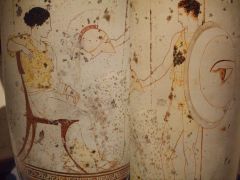
|
Departure lekythos, 440BC, Achilles painter husband is taking his helmet, leaving for war and will not likely return quiet and emotional good foreshortening in the woman as well as anatomy uses lighter brown and smaller brushes to show muscles painted bodies then clothes |
|

|
Apolian pelike 350BC, Painter of the siren citharist red figure with lots of overpaint; very floral representation of Eros-very androgynous has jewelry; more painterly style |
|
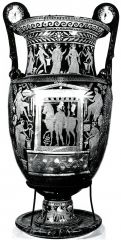
|
apulian volute krater 325BC, Baltimore painter dionyphonus scene at neck woman being decorated at foot funerary scene at belly;naiskos depicted with deceased inside, figures giving offerings surrounding him |
|

|
Apulian bell krater 350BC scenes from theatre gives and idea of what production would look like exaggerated features represent masks |
|

|
Darius volute krater 325BC, Darius painter last of the great apulian painters deals w/contemporary events lots of details in clothes, central figure is Darius-persian king below a greek counting money with persians giving tribute above is gods athena presenting the representation of greece to zeus (Hellas) representation of asia on the end- |

